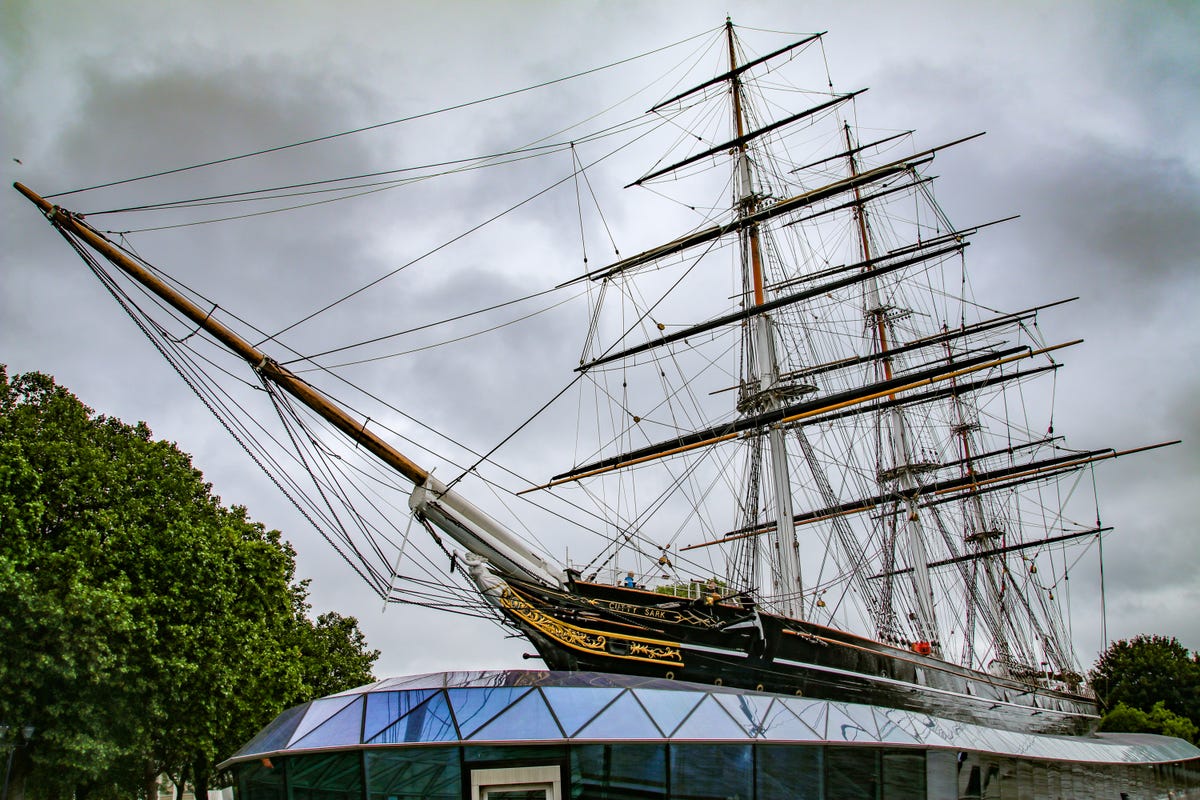
Cutty Sark
After travelling the world, the Cutty Sark is just just a short ride from central London. For the full story behind this tour, check out Cutty Sark: A tour of 147 years of sailing history.
Figurehead
Named after a line about a poorly clad witch in a Robert Burns poem, the Sark's figurehead is said witch carved in white.
Entrance at the stern
The Sarkis suspended above its drydock, and the glass greenhouse that surrounds its hull vaguely implies the water and waves. You enter under the stern.
Rudder
Inside is far more impressive, with the ship hovering in a lattacework of beams.
Hull cut
Given how immaculate the rest of the ship is, this decision to make the main entrance to the ship via a hole cut in the hull seems odd.
Structure
The hull is a skeleton of metal, clad with wood and more metal.
Cargo hold
During its shipping days this would have been packed with tea, wool or other goods.
History in screens
Today there are short clips describing the ship's history.
Model skeleton
The model in the foreground shows the iron framework of the ship, which you can see full size behind it.
Tween deck
The next deck up is the Tween deck, which was also used for cargo. Multiple exhibits line the space now.
Fo'c's'le
Once a place where upwards of 20 men slept, it was later used for cargo and the sailors slept in cabins on deck (which you'll see later).
Porthole view
A typical British view out the porthole, though there are fewer and fewer telephone boxes every year.
Tween deck aft
It's nice that they didn't pack this space full of exhibits and artifacts. It gives a better sense of the size of these ships.
On deck
The bow of the ship, fully laid out with all its running gear.
Fresh meat
This bacon had a decided woody flavor.
Wet and rainy
The deck was wet, and the last time I toured a wet British ship I sprained two fingers in a fall. Being weather in Britain, it changed completely over the next 30 minutes, to a bright sunny day.
Rigging
In full kit, the Sark had 36,000 square feet (3,345 square meters) of sails. At various times in its life, it had far less so fewer crew were required.
Cabins on deck
Along the right (the center of the ship) are a series of cabins that held work and sleeping space for the crew.
Galley
The ship's tiny galley, featuring a cameo of my hand and camera.
Workshop
This is the carpenter's workshop, a handy thing to have on a ship made primarily of wood.
Sleep tight
If you watch a show like "Deadliest Catch," you'll notice how little the bunks of the crew have changed in 150 years.
Chest
In the center is a seaman's chest, where he kept all his belongings for the multi-month trip.
Scrubbin'
Note the display so kids can try out mopping and scrubbing the deck. Seems like a clever way for the museum to get help cleaning.
Ghost in the machine
A "real" officer talking about what life was like on the ship. A clever use of a projector and glass. Similar to my favorite Disney effect at the Haunted Mansion (was that a spoiler?)
Ropes and pullies
Though the Cutty Sark had many sails, it only had a crew of around 30; fewer in later years when they reduced the total number.
Stern weather
Some ominous looking clouds over the stern.
Wheel
I have to say this confused me. Why is the wheel "facing" the wrong way. Wouldn't you want the sailor steering the boat to be able to see where he's going?
Back inside
The Master's Cabin, just down the ladder from the bridge. A few decades after it was built, a later owner expanded one of the smaller cabins and made a larger suite for the captain.
Saloon
An all purpose room, generally used as the officer's mess, but also to entertain guests and more.
Second Mate's cabin
The second mates did a bit better than the lowly crew members, but had to share their room.
Pantry
The ship's pantry. Most meals would be salted meats, vegetables and so on.
Sun?
After reemerging from belowdecks, the sun had come out. I'm sure Londoners were horrified.
Rudder from below
A quick elevator ride (or stairs) bring you to the big open space below the ship, where there's a small cafe where you can stare at the massive rudder.
Keel
This is a unique angle as far as I know for viewing a sailing ship. The tiered steps of the drydock have a few displays and offer a place to sit.
On land dreaming of sea
The blue greenhouse (bluehouse) cradles the ship like the water once did, water that is so close but never to touch the hull again (probably...).
Permission to disembark
Such a well-preservied and gorgeous piece of history.
For the full story behind this tour, check out Cutty Sark: A tour of 147 years of sailing history.

